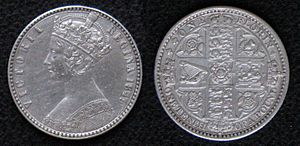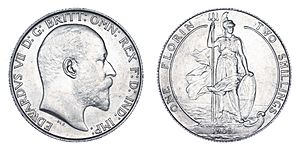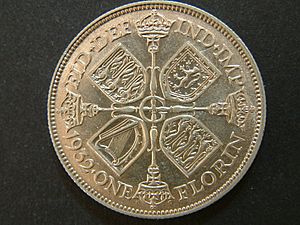Florin (British coin) facts for kids
| United Kingdom | |
| Value | 2 shillings |
|---|---|
| Mass | 11.31 g |
| Diameter | (1849) 28.0 mm (1851–1886) 30.0 mm (1887–1892) 29.5 mm (1893–1970) 28.5 mm |
| Edge | Milled |
| Composition | (1849–1919) 92.5% Ag (1920–1946) 50% Ag (1947–1970) Cupronickel |
| Years of minting | 1849–1970 |
| Obverse | |
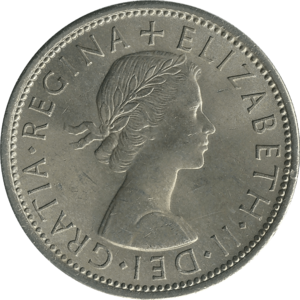 |
|
| Design | Profile of the monarch (Elizabeth II design shown) |
| Designer | Mary Gillick |
| Design date | 1953 (portrait) 1954 ("BRITT OMN" removed) |
| Reverse | |
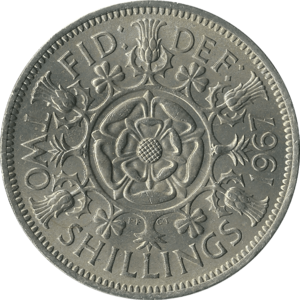 |
|
| Design | Various (floral design shown) |
| Designer | Edgar Fuller and Cecil Thomas |
| Design date | 1953 |
The British florin was a special coin. It was also called a two-shilling piece. This coin was worth one-tenth of a pound, or 24 pence.
The florin was made from 1849 until 1967. Some special ones for collectors were made in 1970. It was the last old coin to be removed from circulation in 1993. For many years, it was used alongside the ten-pence coin, which looked and was worth the same.
The florin was created as part of an idea to change British money to a decimal system. This means everything would be based on tens, like our money today. The first florins, made in 1849, caused a stir. They didn't include "By the Grace of God" in Queen Victoria's titles. Because of this, they were called the "Godless florin".
In 1851, a new design came out, known as the "Gothic florin". This was because of its fancy design and lettering style. For most of its history, the florin showed shields or symbols of the UK's nations. But from 1902 to 1910, it featured a figure of Britannia, a symbol of Britain.
In 1911, when George V became king, the florin went back to the shield and sceptre design. It kept this look until 1937. Then, new national symbols were added. This theme continued until the coin stopped being made. A new design was used from 1953 for Elizabeth II. In 1968, before the big change to decimal money, the Royal Mint started making the ten-pence coin. The old florin stayed in use until the ten-pence coin became smaller. Then, older coins like the florin were finally taken out of circulation.
Contents
The Florin's Story
Why the Florin Was Made
The idea to change British money to a decimal system started a long time ago, in 1682. Other countries like the United States and France changed their money in the late 1700s and early 1800s. This made people in Britain want to do the same.
In 1847, a politician named Sir John Bowring suggested making coins worth one-tenth and one-hundredth of a pound. Many people supported his idea. The government decided to make a coin worth one-tenth of a pound (two shillings) to see what people thought.
There were many ideas for the coin's name, like centum or dime. They finally chose florin. This wasn't because of an old English coin. It was because the Netherlands had a coin called a florin, or gulden, that was similar in size and value.
Victorian Florins (1849–1901)
The first florins were made in 1849. They had a "Gothic" style. They showed a young Queen Victoria and crowned shields of the United Kingdom on the back. This new florin looked a lot like the Gothic crown coin from 1847. The front was designed by William Wyon, and the back by William Dyce.
The 1849 florin was made of silver. It weighed 11.3 grams and was 28 millimetres (1.10 in) wide. The coin clearly showed its value with the words "ONE FLORIN ONE TENTH OF A POUND". To help with the decimal experiment, the half crown (worth two shillings and sixpence) was not made for a while. Both coins were used until decimalisation.
These first coins surprised people. For the first time in almost 200 years, a British coin showed the monarch wearing a crown. Even more surprising was the writing on the front: "VICTORIA REGINA 1849". It left out "D G" which means "By the Grace of God". This is why it was called the "Godless florin". People also noticed it left out "F D" for "Defender of the Faith". The Master of the Mint, Richard Lalor Sheil, was even suspected of trying to cause trouble. But it was actually Queen Victoria's husband, Albert, Prince Consort, who suggested the wording. Sheil said it was a mistake, and the florin was changed in 1851.
The new florin's width grew to 30 millimetres (1.18 in). All the letters on the coin were in a fancy "Gothic script". This is why it's called the Gothic florin. The date was written in Roman numerals. The Latin words on the front now said "VICTORIA D G BRITT REG F D". The back still said "ONE FLORIN ONE TENTH OF A POUND". The idea for decimal money didn't go further at that time. The Gothic Florin was made every year until 1887, except for 1861 and 1882.
In 1887, for Victoria's Golden Jubilee, the coins were redesigned. A new picture of the queen as an older woman appeared. This was called the "Jubilee coinage". The flowers were removed from the florin's back. They were replaced by sceptres between shields, with a Garter Star in the middle. The Jubilee design was not very popular. The florin's width was reduced to 29.5 millimetres (1.16 in). The words on the front said "VICTORIA DEI GRATIA", and the back said "FID DEF BRITT REG". It didn't say the value. The Jubilee florin was made from 1887 to 1892.
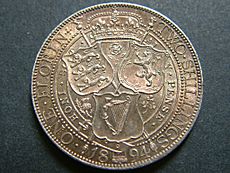
Because the Jubilee design wasn't liked, a committee suggested new designs in 1891. A new picture of the queen, called the "Veiled Head" or "Old Head", was used from 1893. To make it easier to tell apart from the half crown, the florin's width was made smaller, from 29 to 28.5 millimetres (1.14 to 1.12 in). The front said "VICTORIA DEI GRA BRITT REGINA FID DEF IND IMP". The back showed three shields with a rose, shamrock, and thistle (symbols for England, Scotland, and Ireland) under a crown. It also said "ONE FLORIN TWO SHILLINGS". This design by Sir Edward Poynter was used every year until Victoria died in 1901.
Edward VII Florins (1901–1910)
Both sides of the florin were redesigned when Victoria's son, Edward VII, became king. The new designs were made by George William de Saulles. Edward VII florins were made every year from 1902 to 1910. They still weighed 11.3 grams and were 28.5 millimetres wide.
The front showed the King's head facing right. The back had a unique design: a figure of Britannia standing, holding a shield and a trident. It said "ONE FLORIN TWO SHILLINGS" with the date. This design was made to help people tell the florin apart from the half crown. The modern Britannia coins, made for collectors, have a back design that looks very similar to this Edwardian florin.
George V Florins (1910–1936)
Florins with George V's head were made every year he was king (1910–1936), except 1910 and 1934. The first design (1911–1926) was similar to the 1887 double florin. The coin's weight and width stayed the same.
However, the price of silver went up. So, in 1920, the coin's metal mix changed from 92.5% silver to 50% silver. It changed again in 1922 and 1927. The Royal Mint was trying to find a silver mix that would still look good as the coin wore out. The front of the early George V florin said "GEORGIVS V D G BRITT OMN REX F D IND IMP". The back said "ONE FLORIN" and the year.
A changed florin, made from 1927 to 1936, was designed by George Kruger Gray. It still had shields and sceptres, but the crowns were moved from the shields to the sceptres. A "G" for the King's initial was in the middle. The front now said "GEORGIVS V DEI GRA BRITT OMN REX" (George V, by the Grace of God King of All the Britains). The back said "FID DEF IND IMP" (Defender of the Faith, Emperor of India) with the date and "ONE FLORIN".
Edward VIII Florin (1936)
In 1936, when Edward VIII was king, coins were still being made with George V's designs. No coins with Edward VIII's picture were officially released for people to use. A sample florin was made for King Edward. It would have been approved around the time he gave up the throne in December 1936.
Usually, the monarch's head faces the opposite direction of the previous king or queen. George V faced left, but Edward thought his left side looked better. So, the sample coin showed his head facing left. The back, by Kruger Gray, had a crowned rose with a thistle and shamrock. It said "FID DEF IND IMP TWO SHILLINGS 1937".
George VI Florins (1936–1952)
King George VI's florin was made every year from 1937 to 1951. It looked a lot like the one planned for his brother, Edward VIII. The words "ONE FLORIN" were left off, and they stayed off for the rest of the coin's life.
The front, by Thomas Humphrey Paget, showed the King's head facing left. The back, by Kruger Gray, had a crowned rose with a thistle and shamrock on each side. It said "FID DEF IND IMP TWO SHILLINGS" with the date until 1948. From 1949, the coins were made without "IND IMP". This was because India had become independent.
From 1947, the metal changed for all British silver coins. They became 75% copper and 25% nickel. This was because Britain needed to return silver to the United States. The florin's width and weight stayed the same, even with the new metal.
Elizabeth II Florins (1953–1970)
Florins were made for Queen Elizabeth II every year from 1953 to 1967. Some special proof coins were made in 1970. The front showed Queen Elizabeth's head, designed by Mary Gillick. It said "ELIZABETH II DEI GRATIA BRITT OMN REGINA" (in 1953 only) or "ELIZABETH II DEI GRATIA REGINA" (in other years). This change was made because the British Commonwealth now included some republics.
The back, by Edgar Fuller and Cecil Thomas, showed a Tudor rose in the middle. It was surrounded by thistles, shamrocks, and leeks. It also had the Latin words "FID DEF", the coin's value, and the date. These designs were chosen after a public competition.
As part of the plan to change to decimal money, the ten pence coin was introduced in 1968. It was the same size, weight, and metal as the florin. So, florins stopped being made for everyday use after 1967. The new ten pence coins and the old florins were used together. After Decimal Day (February 15, 1971), florins (usually from 1947 or later) were still used as ten pence pieces.
In 1987, the government decided to make the ten pence coin smaller. A smaller ten pence coin came out in 1992. After that, the old florin was officially taken out of circulation on June 30, 1993. The florin, which was the first coin made for the decimal system, was the last old coin to be removed from circulation.
How Many Florins Were Made
Here's a list of how many florins were made each year.
Victoria
- 1849 - 413,320
- 1851 - 1,540
- 1852 - 1,014,552
- 1853 - 3,919,950
- 1854 - 550,413
- 1855 - 831,017
- 1856 - 2,201,760
- 1857 - 1,671,120
- 1858 - 2,239,380
- 1859 - 2,568,060
- 1860 - 1,475,100
- 1862 - 594,000
- 1863 - 938,520
- 1864 - 1,861,200
- 1865 - 1,580,040
- 1866 - 914,760
- 1867 - 423,720
- 1868 - 869,940
- 1869 - 297,000
- 1870 - 1,080,648
- 1871 - 3,425,605
- 1872 - 7,199,690
- 1873 - 5,921,839
- 1874 - 1,642,630
- 1875 - 1,117,030
- 1876 - 580,034
- 1877 - 682,292
- 1878 - 1,786,680
- 1879 - 1,512,247
- 1880 - 2,161,170
- 1881 - 2,376,337
- 1883 - 3,555,667
- 1884 - 1,447,379
- 1885 - 1,758,210
- 1886 - 591,773
- 1887 - 543,525 (Gothic)
- 1887 - 1,233,378 (Jubilee)
- 1888 - 1,647,540
- 1889 - 2,973,561
- 1890 - 1,684,737
- 1891 - 836,438
- 1892 - 283,401
- 1893 - 1,667,415
- 1894 - 1,952,842
- 1895 - 2,182,968
- 1896 - 2,944,416
- 1897 - 1,699,921
- 1898 - 3,061,343
- 1899 - 3,966,953
- 1900 - 5,528,630
- 1901 - 2,648,870
Edward VII
- 1902 - 2,204,698
- 1903 - 995,298
- 1904 - 2,769,932
- 1905 - 1,187,596
- 1906 - 6,910,128
- 1907 - 5,947,895
- 1908 - 3,280,010
- 1909 - 3,482,829
- 1910 - 5,650,713
George V
- 1911 - 5,957,291
- 1912 - 8,571,731
- 1913 - 4,545,278
- 1914 - 21,252,701
- 1915 - 12,357,939
- 1916 - 21,064,337
- 1917 - 11,181,617
- 1918 - 29,211,792
- 1919 - 9,469,292
- 1920 - 15,387,833
- 1921 - 34,863,895
- 1922 - 23,861,044
- 1923 - 21,546,533
- 1924 - 4,582,372
- 1925 - 1,404,136
- 1926 - 5,125,410
- 1927 - 15,000 (Proof Only)
- 1928 - 11,087,186
- 1929 - 16,397,279
- 1930 - 5,733,568
- 1931 - 6,566,331
- 1932 - 717,041
- 1933 - 8,685,303
- 1935 - 7,540,546
- 1936 - 9,897,448
George VI
- 1937 - 13,033,183
- 1938 - 7,909,388
- 1939 - 20,850,607
- 1940 - 18,700,338
- 1941 - 24,451,079
- 1942 - 39,895,245
- 1943 - 26,711,987
- 1944 - 27,560,005
- 1945 - 25,858,049
- 1946 - 22,300,254
- 1947 - 22,910,085
- 1948 - 67,553,838
- 1949 - 28,614,939
- 1950 - 24,375,003
- 1951 - 27,431,747
Elizabeth II
- 1953 - 11,998,710
- 1954 - 13,085,422
- 1955 - 25,887,253
- 1956 - 47,824,500
- 1957 - 33,071,282
- 1958 - 9,564,580
- 1959 - 14,080,319
- 1960 - 13,831,782
- 1961 - 37,735,315
- 1962 - 35,129,903
- 1963 - 25,580,000
- 1964 - 16,313,000
- 1965 - 48,723,000
- 1966 - 84,547,000
- 1967 - 22,000,000
- 1970 - 750,476 (Proof Only)


